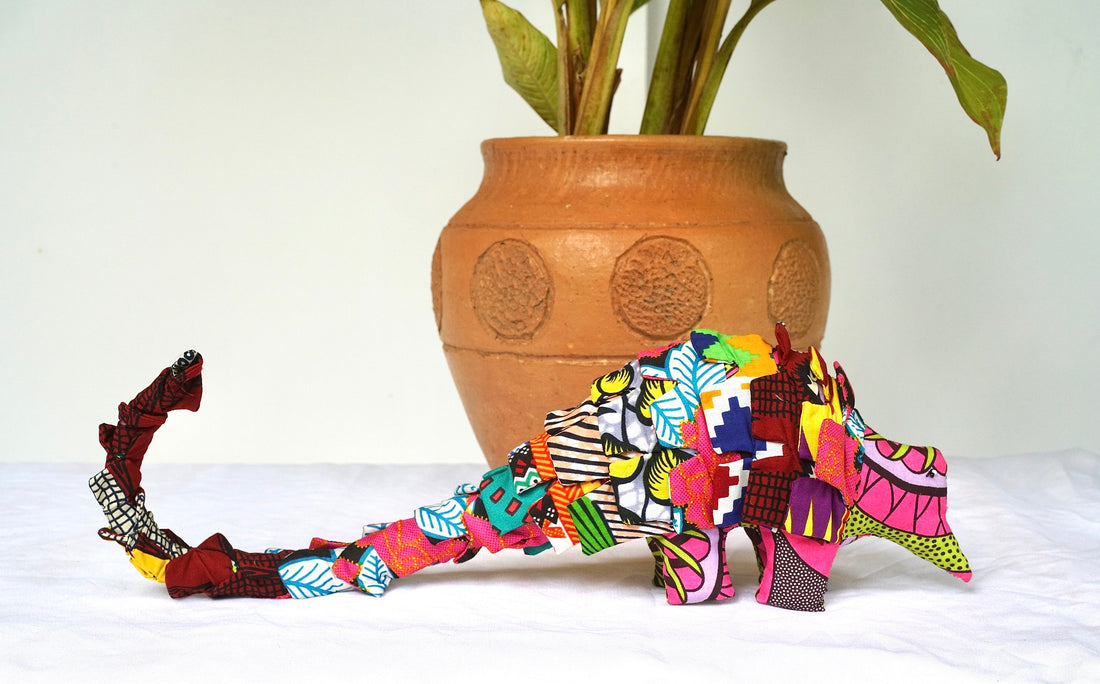
The Pangolin
Share
We are dedicating this entire week to the pangolin! Follow the step-by-step process of making of Ndara pangolins and more facts on instagram and facebook. It will be fun!
Why you say? Because Central African Republic is the only country where all four African pangolins are found.
Pangolins are mammals, easily recognized by their unique body cover made of large, overlapping keratin scales. They are often called "scaly anteaters” because of their preferred diet of ants and their many scales. They are shy and harmless. The tragic truth is that they are becoming increasingly known as the most trafficked mammal in the world and are on the fast track to extinction.

Tens of thousands of pangolins are poached every year, killed for their scales for use in traditional Chinese medicine and for their meat. The implications of the loss of such a specialized and evolutionary distinct animal could have far reaching impacts on the habitats in which they occur as they help in pest control (myrmeccophagus – ant and termite eating). A pangolin curls up in a ball when threatened and uses the sharp scales for protection. The name pangolin comes from the Malay word pengguling, meaning “one who rolls up”. An effective armor against hyenas or lions, but quite the opposite when the hunter is a human. To reach their prey, pangolins have a very long tongue and distinctive strong curved claws specialized for breaking into ant nests.
Seeing a pangolin in the wild is a very special experience. Especially since pangolins are very difficult to find, making it a tough task for scientists to study them or to see them in the wild.

Given the link between the pangolin and the Central African Republic it was a given that the pangolin was one of the first animals that Ndara started making. It takes the artisans several days of full-time work to create the pangolin. It starts with the initial cutting and hand stitching of the body, putting the wire into the tail, and ripping the foam filling to small pieces. The work continues with stitching long strands of scales, before the strands are carefully stitched in layers, one by one, onto the body.

Some fun facts about Pangolins:
- A pangolin’s scales make up approximately 20% of its body weight
- The pangolin’s stomach is designed to grind up ants and termites using ingested sand and stones and keratinous spines found on their stomach lining, similar to a bird’s gizzard.
- World Pangolin Day is celebrated every year on the 3rd Saturday of February
- The black-bellied pangolin has the longest tail of all pangolins with 75 vertebrates in total, with 47 comprising the tail, a record among mammals.

Two amazing pangolin projects you should know about:
1. Sangha Pangolin Project: The project started as a small pangolin conservation and rehabilitation project, rescuing, rehabilitating, and releasing pangolins out of the trade into the tropical Dzanga-Sangha Forest in CAR, creating local jobs and raising awareness of the pangolin's plight. The project is quite unique in CAR; it focused solely on pangolins in the area (white-bellied, black- bellied and giant pangolins). It has now developed into a research project and works very closely with the Ba’aka village communities living alongside the protected wildlife areas to actively participate in and benefit from conservation and research activities of the project.
2. Tikki Hywood Foundation: Based in Zimbabwe, but also operating in Liberia and Cameroon, the foundation supports many organizations involved in pangolin conservation in central and west Africa. They have almost three decades of experience in working with pangolins and are a pioneer in rescue and rehabilitation of this enigmatic species. They have developed many of the methods for captive care and rehabilitation of seized pangolins employed today. Tikki Hywood Foundation has recently partnered with African Parks in CAR. As part of their shared vision to conserve pangolins in Africa, this collaboration is facilitating training in best practices and procedures for pangolin rehabilitation, the provision of specialized support and the resources needed to scale capacity for the protection and wellbeing of rescued and orphaned pangolins across the continent.
Acknowledgements: Thank you to Maja Gudehus for so graciously sharing her expert knowledge with us, and to Sangha Pangolin Project for the pictures of pangolins in the wild.
